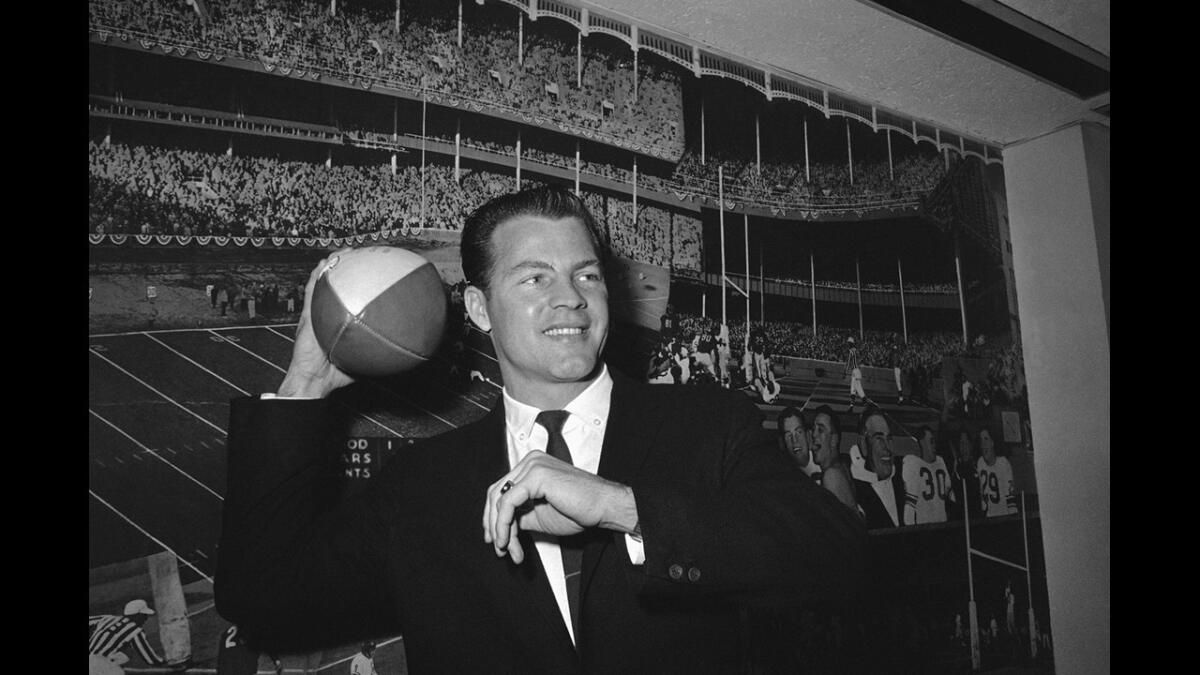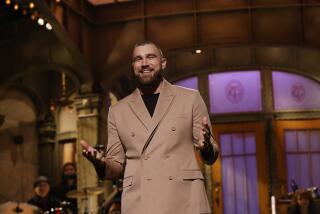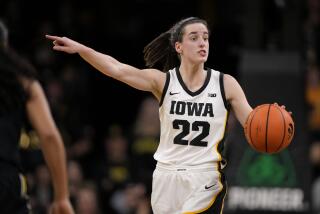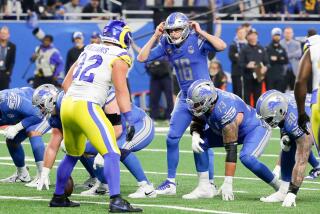Frank Gifford dies at 84; Pro Football Hall of Famer, TV sportscaster

Halfback Frank Gifford cocks his passing arm as he stands in front of a photo mural of the Polo Grounds at the offices of the New York Giants in New York’s Coliseum on April 2, 1962.
As a kid, Frank Gifford was never in one place long. The son of an oilfield roughneck who was constantly looking for work, he moved 47 times before starting high school in Bakersfield.
But as an adult, the low-key, likable athlete with movie-star looks stayed put — and became a reliable, welcome, instantly recognizable presence for millions of sports-loving Americans.
Gifford, a former NFL star who made a seamless transition into sportscasting and ultimately spent 27 years with ABC’s “Monday Night Football,” died Sunday at his home in Greenwich, Conn. He was 84.
Gifford died unexpectedly from natural causes, according to a statement from his family. He was married to TV personality Kathie Lee Gifford.
For all his success as a football player, first at USC, then with the New York Giants — and that success led to his induction into the Pro Football Hall of Fame in 1977 — Gifford later became more famous for his low-key role as the even-handed play-by-play announcer, counterbalancing the pontificating Howard Cosell, the hayseedy Don Meredith, the bombastic Alex Karras and others who traipsed in and out of the ABC booth for the weekly pro football ritual.
By the time he was done in 1998 — after his “good guy” reputation was tarnished when he was caught in a supermarket-tabloid scandal — Gifford called 588 consecutive games for ABC, and, as an announcer and then an analyst, had become as much a part of the country’s Monday night routine as the game itself. He also was involved in Olympic telecasts, “Wide World of Sports” and countless TV specials and occasionally appeared, usually playing himself, in weekly entertainment TV shows.
“He was an icon,” NFL Commissioner Roger Goodell said in a statement Sunday. “Frank’s talent and charisma on the field and on the air were important elements in the growth and popularity of the modern NFL.”
If he was understated in the broadcast booth, he was anything but on the football field. He played on offense, as a running-passing tailback, and on defense, as a safety, at USC, where he was an All-American as a senior in 1951. He also caught passes, punted, kicked field goals and extra points, and returned punts and kickoffs.
He was even better as a pro, one of the last to play both ways in a fast-growing NFL that was tending more to specialization with each succeeding season. He began with the Giants primarily as a defensive back who also played offense, then was switched to primarily a running back who also played defense. Then, after sitting out a season to fully recover from a violent tackle by another of the dwindling number of two-way players, Chuck Bednarik of the Philadelphia Eagles, he came back for three more seasons as a pass-catching flanker.
In 12 NFL seasons, he was all-pro six times, was voted the league’s most valuable player in 1956, when he led the Giants to the league championship, and made the Pro Bowl eight times, at three positions — defensive back, running back and flanker.
He also played in the 1958 NFL title game, in which the Baltimore Colts, with Johnny Unitas, Raymond Berry and Alan Ameche, beat the Giants in sudden-death overtime, 23-17. That game was played before a sellout crowd in Yankee Stadium three days after Christmas, drew a national TV audience of 45 million and has long been considered the spark that kindled pro football’s transformation from college football’s poor relative to powerhouse of the sports world.
In celebration of the 50th anniversary of that game in 2008, Gifford, with Peter Richmond, wrote “The Glory Game: How the 1958 NFL Championship Game Changed Football Forever.” It is one of four books co-written by Gifford.
Frank Newton Gifford was born to Weldon and Lola Gifford on Aug. 16, 1930, in Santa Monica. His story, in some ways, matches those of many other born-in-the-Depression success tales — up by the bootstraps. Except in Gifford’s case, he wasn’t much interested in bootstraps, success or much of anything at all.
Because he didn’t spend much time in any one school, the young Frank didn’t bother with friendships and, in fact, didn’t bother much with what school had to offer. He skipped whenever he could and was no scholar when he attended.
“I even failed wood shop,” he said of his high school days.
Bakersfield High, though, was where things started to come together for Gifford. He was cut from the lightweight football team as a scrawny 5-foot-2 freshman, then sent down from the varsity to the lightweight team as a sophomore. But he grew the summer before his junior season, made the varsity team, and soon became coach Homer Beatty’s pet project.
Gifford stepped in as a replacement when the team’s starting quarterback was killed in a traffic accident just before the season began and, with surprisingly strong running and passing skills, quickly became Bakersfield’s star.
Beatty, convinced that Gifford could play college football, urged him to try for a scholarship to USC. He spent a semester at Bakersfield Junior College, making junior college All-American, then transferred to USC. He was academically ineligible for football but took night classes, as well as daytime studies, and finally became eligible.
While his scholastic career was improving, though, his football career was stagnating.
In his autobiography, “The Whole Ten Yards,” Gifford wrote, “[Coach Jeff Cravath] simply didn’t know what to do with a quarterback turned halfback who was also a good defensive back, punter and place kicker. So he shunted me to safety and extra point kicker, and that’s where I basically languished for the next two years.”
Before Gifford’s senior season, however, Jess Hill replaced Cravath as coach, and Hill, as had Beatty before him, quickly recognized Gifford’s many talents.
“Hill switched us from the T-formation to a combination of the winged T and the single wing and built his attack around me at tailback,” Gifford wrote. “Besides continuing to play defensive back, I ran, passed and blocked — and we won our first seven games.”
As a senior, Gifford scored seven touchdowns, ran for 841 yards, completed 32 of 61 passes, caught 11 passes, intercepted three more, and kicked 26 extra points and two field goals.
Then it was off to the Giants, where stardom awaited — but not immediately. As the team’s No. 1 draft choice, Gifford ran into resentment from the Giants’ “crusty old veterans,” and butted heads with coach Steve Owen, who saw him as a cornerback and fill-in for running back Kyle Rote. The next season was more of the same, but with an emphasis on offense as Gifford replaced an injured Rote.
Once again, a coaching change recharged Gifford’s career. Jim Lee Howell replaced Owen in 1954, bringing with him Vince Lombardi as offensive coordinator.
“Just as Homer in high school and Jess in college rescued me from the defense and built their offense around me, so did Vince in the pros,” Gifford recalled. “Lombardi believed that the left halfback position — now my permanent home — was the key to a successful offense, the point of attack.”
As a pro, Gifford rushed for 3,609 yards and 34 touchdowns and caught 367 passes for 5,434 yards and 43 additional touchdowns but, perhaps unfairly, may be best remembered for being on the wrong end of Bednarik’s tackle, possibly the most famous tackle in NFL history.
“I made many, many good tackles,” Bednarik told the New York Post in 2005. “It just so happens that one was in the right place at the right time against the right person. It’s carrying on for eternity, it seems like.”
On Nov. 20, 1960, in Yankee Stadium, the Giants were driving for the tying touchdown with less than two minutes left when quarterback George Shaw passed to Gifford across the middle. The pass was off target and Gifford had to reach back for it. When he turned around, there was linebacker Bednarik, who leveled the unsuspecting Gifford.
“He caught him as flush as you could catch him,” said Tom Brookshier, who was playing defensive back for the Eagles that day. “Giff never saw him coming.”
Gifford fumbled, the Eagles recovered and Bednarik celebrated with a raised fist over the out-cold Gifford, Bednarik later saying he was celebrating the game-clinching recovery, not the tackle. Gifford retired after that season, in part because he’d been in a coma after the hit, then returned to the Giants for three more seasons in 1962.
Years later, when the previously twice-married Gifford began dating Kathie Lee Epstein Johnson, Gifford warned her that she might be frequently hearing the name Bednarik. “Bednarik, is that a type of pasta?” she replied.
Gifford and Johnson married in 1986 and the union seemed one of those idyllic celebrity marriages.
In her 1992 memoir, “I Can’t Believe I Said That,” Kathie Lee wrote, “Frank is my husband, my confidant, lover, therapist, parenting partner and best friend. Cheating is out of the question. Sure, Frank sees sexy flight attendants and businesswomen when he flies around the country. But the only come-on line he gets anymore is ‘C’mon, Frank, show me a picture of [son] Cody.’“
But in 1997, Gifford was caught in a compromising situation with Suzen Johnson, a married former flight attendant, in what was generally considered a sting operation by the supermarket tabloid Globe. Both Gifford and Kathie Lee originally denied the story but later acknowledged it when the tabloid offered pictures and sound recordings of the hotel rendezvous.
Many believe the publicity led to Gifford’s retirement from “Monday Night Football,” but he and Kathie Lee remained together. In addition to his wife, Gifford’s survivors include children Jeff, Kyle and Victoria from his first marriage, and Cody and Cassidy, his children with Kathie Lee.
Mike Kupper is a former Times staff writer.
More to Read
Start your day right
Sign up for Essential California for the L.A. Times biggest news, features and recommendations in your inbox six days a week.
You may occasionally receive promotional content from the Los Angeles Times.






